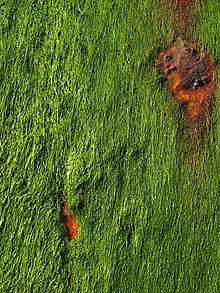Map Snapshot

0 Records
Seasonality Snapshot
No Records
No images available
Source: Wikipedia
| Blidingia minima | |
|---|---|

| |
| Scientific classification | |
| Clade: | Viridiplantae |
| Division: | Chlorophyta |
| Class: | UTC clade |
| Order: | Ulvales |
| Family: | Kornmanniaceae |
| Genus: | Blidingia |
| Species: | B. minima
|
| Binomial name | |
| Blidingia minima | |
| Synonyms[1] | |
| |
Blidingia minima is a species of seaweed in the Kornmanniaceae family. It was described by Johann Kylin in 1947.[2]
Description
[edit]The species is 1–10 centimetres (0.39–3.94 in) long by 1–2 millimetres (0.039–0.079 in) wide and is light green in colour.[3] It fronds are tubular with it cell arrangement being irregular and 10 micrometres (0.00039 in) in diameter. Stellate chloroplasts also exist. The tubes rise in groups from the center.[4] It thalli grow as clusters which carry cylindrical and hollow tubes which arise from discoidal cushion.[5] The tubes are 1–20 millimetres (0.039–0.787 in) long and 2 millimetres (0.079 in) wide. Thallus cells are 7 micrometres (0.00028 in) wide and are angular.[6]
Distribution
[edit]The type locality of this species is Helgoland, Germany.[7] The species is found throughout eastern part of Asia in such countries as China, Japan, Korea and eastern part of Russia.[5] It is also found in Azores, Canada, Norway, South Africa, United States, and various gulfs, seas and oceans, such as Gulf of Maine and Gulf of Mexico and in Atlantic and Pacific Oceans and Wadden Sea.[2] Besides this places it have a type locality which is and is also common in Ireland and Great Britain.[8] It was also recorded in Queensland, Australia.[9]
English distribution
[edit]In England, the species was recorded from East Sussex.[10]
Habitat
[edit]It is found growing on cobble, boulders, bedrocks, barnacles, driftwood and even on different algae species throughout the semi-protected and protected areas.[5]
Ecology
[edit]Blidingia minima is considered to be a food for periwinkles.[11]
References
[edit]- ^ "Blidingia minima (Nägeli ex Kützing) Kylin var. minima". University Herbarium. Berkeley: Center for Phycological Documentation. Retrieved June 7, 2013.
- ^ a b Guiry, Michael D (2013). "Blidingia minima (Nägeli ex Kützing) Kylin, 1947". WoRMS. World Register of Marine Species. Retrieved June 6, 2013.
- ^ "Blidingia minima (Nageli ex Kutzing) Kylin, 1947". Svalbard's Macroalgae. Retrieved June 7, 2013.
- ^ "A green seaweed - Blidingia minima". The Marine Life Information Network. Retrieved June 6, 2013.
- ^ a b c "Blidingia minima". Seaweed of Alaska. Retrieved June 6, 2013.
- ^ Joel A. Swanson; Gary L. Floyd (October 1978). "Fine Structure of the Zoospores and Thallus of Blidingia minima". Transactions of the American Microscopical Society. 97 (4): 549–558. doi:10.2307/3226170. JSTOR 3226170.
- ^ Guiry, M.D.; Guiry, G.M. "Blidingia minima". AlgaeBase. World-wide electronic publication, National University of Ireland, Galway.
- ^ "Blidingia minima (Nägeli ex Kützing) Kylin, 1947". AlgaeBase. Retrieved June 6, 2013.
- ^ "Blidingia minima". Department of Environment and Heritage Protection. WetlandInfo. May 9, 2013. Retrieved June 7, 2013.
- ^ "English distribution". BioImages: The Virtual Field-Guide (UK). Retrieved June 7, 2013.
- ^ "Blidingia minima". Ecomare. Archived from the original on June 24, 2013. Retrieved June 6, 2013.
Further reading
[edit]- Kylin, H. (1947). Über die Fortpflanzungsverhältnisse in der Ordnung Ulvales. Vol. 17. Kungl. Fysiografiska Sällskapets i Lund Förhandlingar. pp. 174–182.
- Boraso, A.L. (1970). "Sobre la presencia de Blidingia minima (Nägeli ex Kützing) Kylin var. Minima en la Argentina (Chlorophyta, Ulvaceae)". Physis. 30: 167–170.
- Garbary, D.J.; Tam, C. (1989). "Blidingia minima var. stolonifera var. nov. (Ulvales, Chlorophyta) from British Columbia: systematics, life history and morphogenesis". Nordic Journal of Botany. 9 (3): 321–328. doi:10.1111/j.1756-1051.1989.tb01006.x.
- Iima, M. (1989). "Geographical variation of development and life history of Blidingia minima (Chlorophyceae) from Japan". Scientific Papers of the Institute of Algological Research. 8 (2): 157–185.
- Karsten, U.; Kirst, G.O. (1989). "Intracellular solutes, photosynthesis and respiration of the green alga Blidingia minima in response to salinity stress". Acta Botanica Neerlandica. 102 (2): 123–128. doi:10.1111/j.1438-8677.1989.tb00079.x.
- Prange, R.K. (1978). "An autecological study of Blidingia minima var. subsalsa (Chlorophyceae) in the Squamish estuary (British Columbia)". Canadian Journal of Botany. 56 (2): 170–179. doi:10.1139/b78-022.
- Reis-Santos, R.P. (1992). "Blidingia minima (Nägeli ex Kützing) Kylin var. minima (Monostromataceae - Chlorophyta), ocorrência nova para a costa brasileira". Hoehna. 19: 125–128.
- Swanson, J.A.; Floyd, G.L. (1978). "Fine structure of the zoospores and thallus of Blidingia minima". Transactions of the American Microscopical Society. 97 (4): 549–558. doi:10.2307/3226170. JSTOR 3226170.
- Tatewaki, M.; Iima, M. (1984). "Life Histories of Blidingia minima (Chlorophyceae), especially sexual reproduction". Journal of Phycology. 20 (3): 368–376. doi:10.1111/j.0022-3646.1984.00368.x.
- Woolcott, G.W.; Iima, M.; King, R.J. (2000). "Speciation within Blidingia minima (Chlorophyta) in Japan: evidence from morphology, ontogeny and analyses of nuclear rDNA ITS sequence". Journal of Phycology. 36: 227–236. doi:10.1046/j.1529-8817.2000.99034.x.
